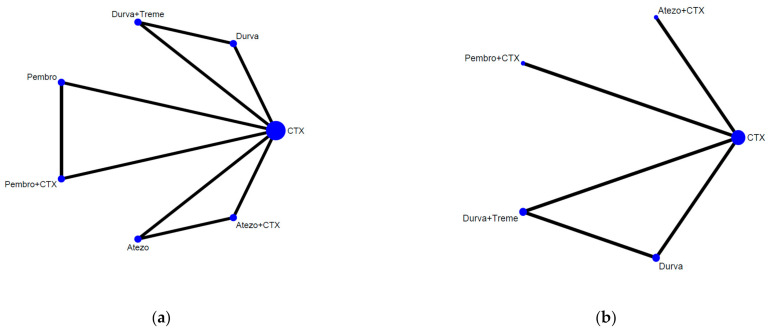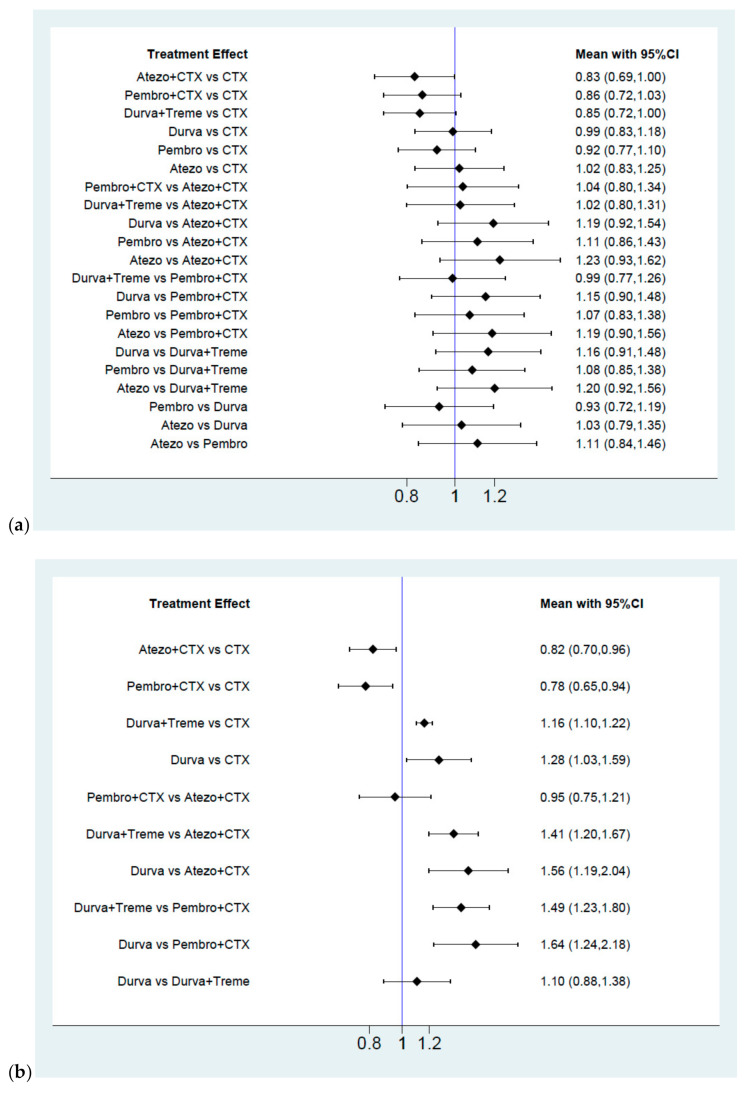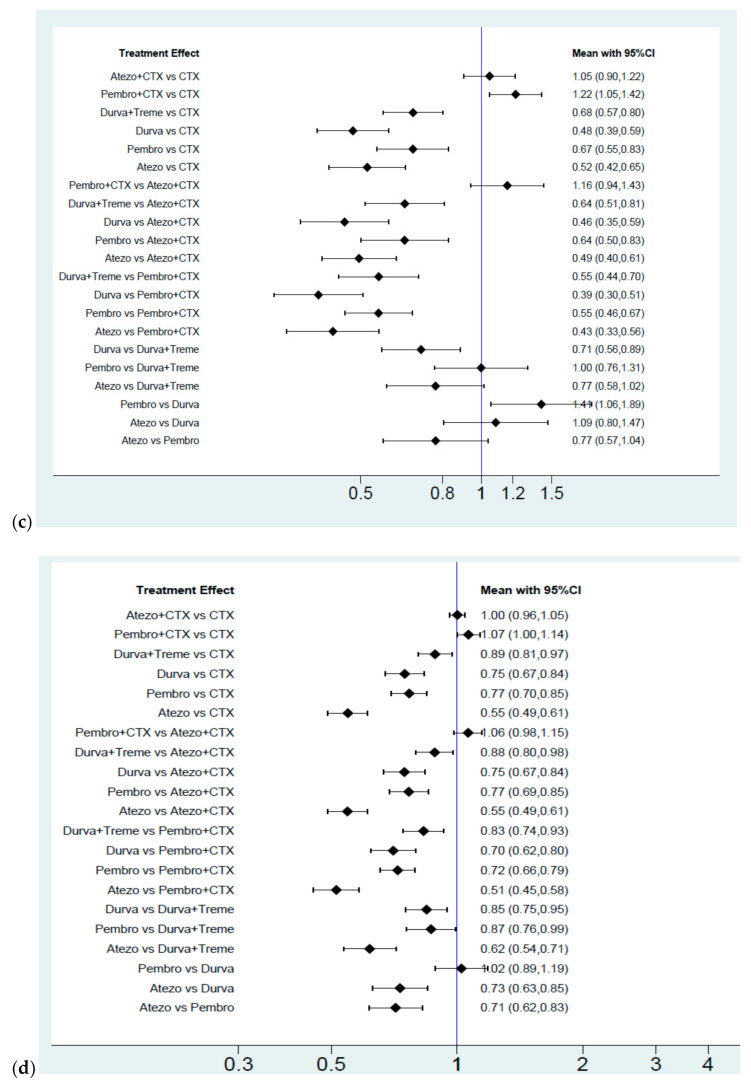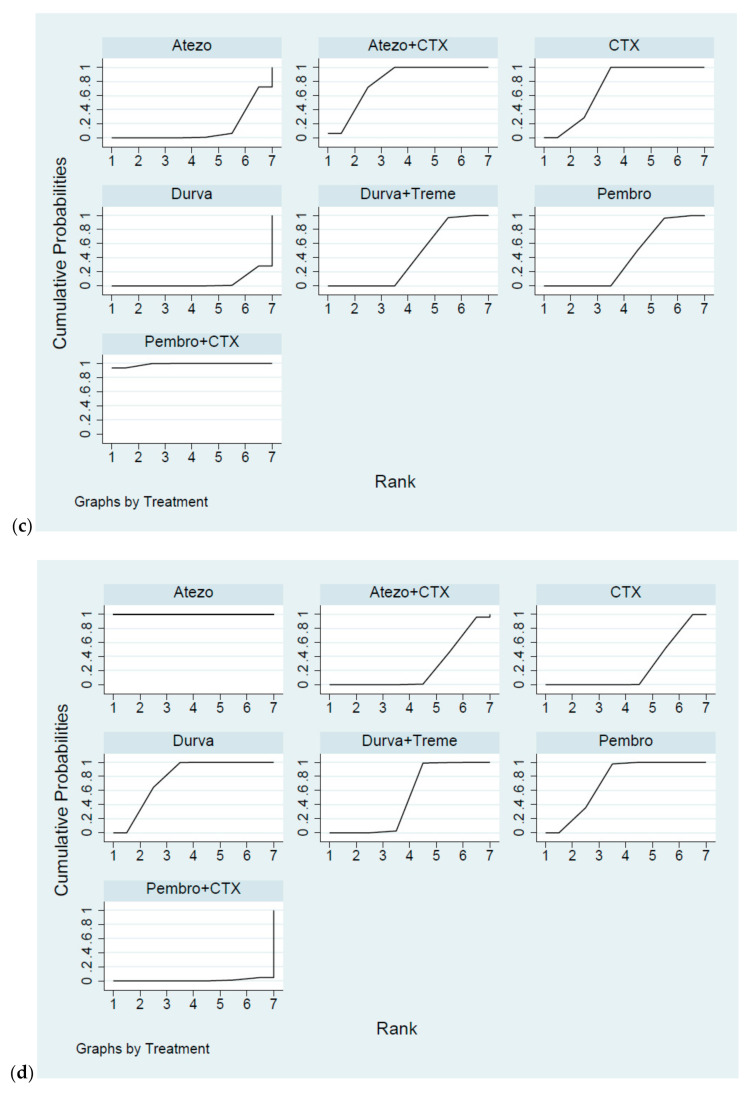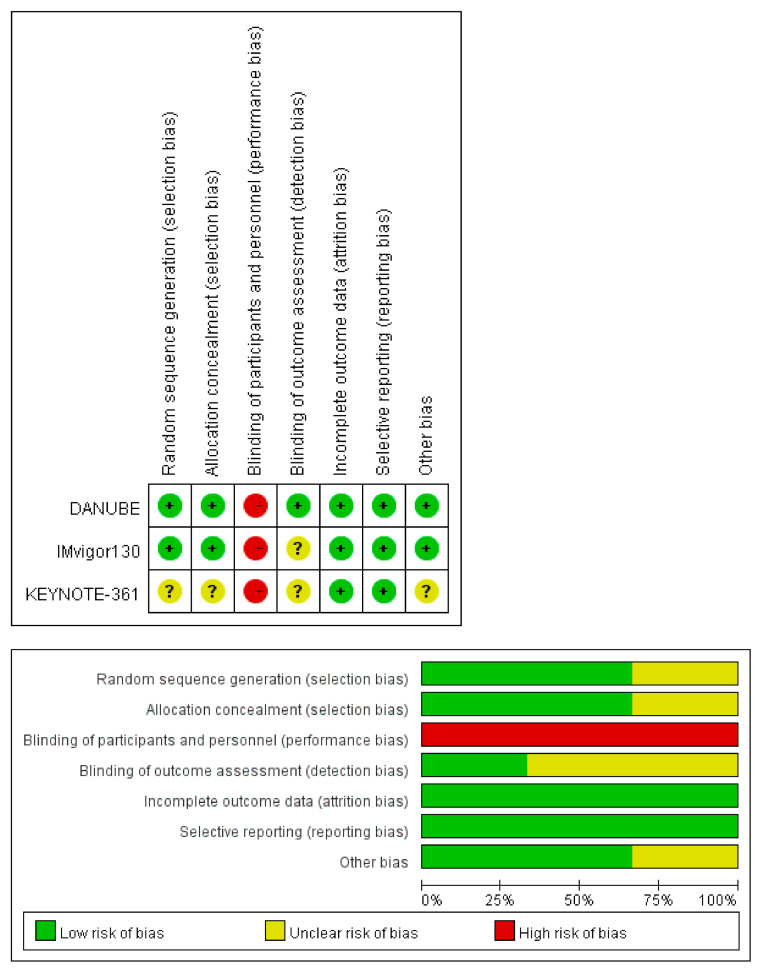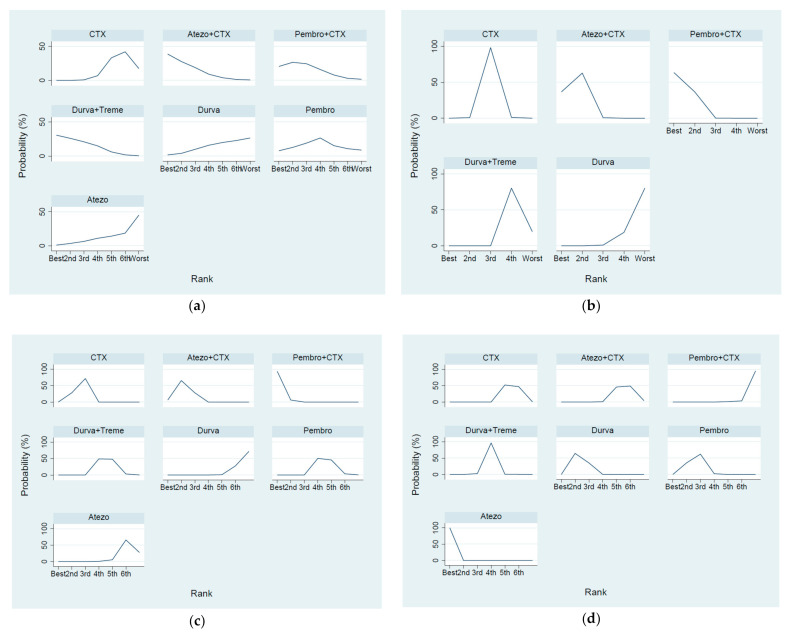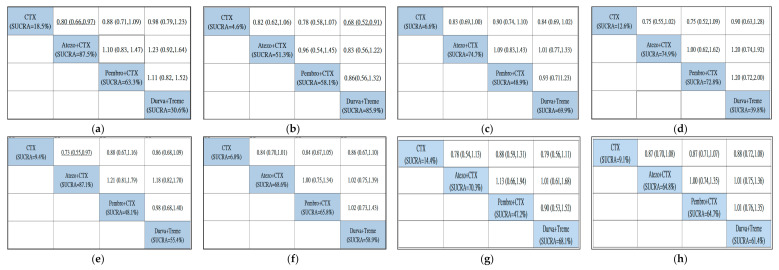Abstract
Simple Summary
On the basis of the efficacy and tolerable safety profiles of immune checkpoints inhibitors (ICIs) in second-line metastatic urothelial carcinoma (mUC) patients, some emerging clinical trials focus on the first-line treatment. Thus, we conducted a network meta-analysis (NMA) to assess and compare the response and toxicity of ICIs in naïve-chemotherapy mUC setting. According to our results, combination therapy (either ICIs plus chemotherapy (CTX) or ICIs plus ICIs) had a higher priority in terms of overall survival. Concerning monotherapy, ICIs are not inferior to CTX in terms of OS. In view of the adverse effect, ICIs are very tolerable, and combination therapy did not lead to a higher incidence of grade 3–5 AEs when compared with CTX.
Abstract
Immune checkpoints inhibitors (ICIs) were considered as second-line treatments in metastatic urothelial carcinoma (mUC) based on better survival benefit and safety profile than chemotherapy (CTX). We aimed to assess different ICIs regimens in the efficacy and safety for front-line treatments in mUC patients. A comprehensive literature search was performed and Phase II-III randomized controlled trials (RCTs) on ICIs for patients with mUC were included. The outcome was evaluated by overall survival (OS), progression of free survival (PFS), objective response rate (ORR), and grade 3–5 adverse events. Network meta-analysis was used to estimate the effect size. Surface under cumulative ranking curves (SUCRAs) were applied to rank the included treatments for each outcome. Results: The survival benefit of a single ICI was non-inferiority to chemotherapy (CTX). Although no superior effects were indicated, combination therapy (either ICIs plus CTX or ICIs plus ICIs) presented better OS compared with CTX alone. In terms of PFS, combination therapy produced a noticeable benefit over CTX. Regarding the SUCRA ranking, atezolizumab plus CTX was associated with the best ranking for OS and pembrolizumab plus CTX was the best in PFS. In terms of safety, a single ICI had better safety profile than CTX and combination therapy had a similar risk of grade 3–5 adverse events with CTX. Conclusions: Our NMA results revealed that combination therapy has better ranking compared with monotherapy in OS and acceptable AEs. ICIs alone present non-inferior OS but a lower incidence of AEs compared with CTX.
Keywords: immune checkpoints inhibitors, urothelial carcinoma, chemotherapy, network meta-analysis
1. Introduction
Metastatic urothelial carcinoma (mUC) arising from upper or lower urinary tract systems has poor prognosis and short-term survival [1]. Currently, platinum (cisplatin or carboplatin) based chemotherapy is considered the first-line treatment for mUC with an overall response rate (ORR) of 40–60% and median overall survival (OS) of 14–15 months [2,3,4]. However, there are some challenges when patients are unfit or intolerable to receive chemotherapy. The most commonly used platinum-based regimens are methotrexate, vinblastine, doxorubicin, and cisplatin (MVAC), as well as gemcitabine plus cisplatin (GC), but they may not be suitable in patients with multiple comorbidities, poor performance status, and renal function impairment [5]. Therefore, alternative first-line treatment replacing chemotherapy for mUC is an important issue in clinical practice.
In recent years, immune checkpoints inhibitors (ICIs) against programmed death 1 (PD-1) and its ligand (PD-L1) have been investigated for mUC which progress despite chemotherapy. Five immune checkpoints inhibitors including two PD-1 inhibitors, pembrolizumab and nivolumab and three PD-L1 inhibitors, as well as atezolizumab, avelumab, and durvalumab have been approved by the Food and Drug Administration for mUC patients with prior chemotherapy or cisplatin ineligible condition [6]. Although UC is a chemo-sensitive cancer, a significant proportion of patients still experience disease progression after first-line chemotherapy. There are several agents that have been investigated in the second-line setting including vinflunine, taxanes, checkpoints inhibitors, anti-angiogenic therapy, etc., [7,8]. A previous network meta-analysis evaluated various second-line therapeutic agents and concluded that there is no evidence to support that one agent is better than the other in terms of OS. However, PD-1/L1 inhibitors can be considered as they are associated with lower toxicity profile [9].
With the promising results of PD-1/L1 inhibitors as a second-line treatment for mUC, there are several emerging clinical trials focusing on PD-1/L1 inhibitors for mUC in the first-line setting. However, no head to head RCTs compare the efficacy and safety among ICIs and combination therapy (either ICIs plus chemotherapy (CTX) or ICIs plus ICIs). As ICIs are very expensive and mUC patients have short-term survival, we urgently need to identify the single best available treatment. Hence, we conducted a network meta-analysis (NMA) to investigate and compare the treatment response and toxicity of PD-1/L1 inhibitors versus chemotherapy as a first-line treatment for patients with mUC.
2. Results
2.1. Literature Search
The search strategy was presented in Appendix A and a total of 1388 studies were imported by the comprehensive search strategy. After eliminating duplication, 1328 studies underwent title/abstract screening and 1294 of them were excluded due to irrelevance, resulting in 34 studies for a full text review. At the end of the process, 13 published studies retrieved from three completed RCTs met our inclusion criteria and remained for qualitative synthesis. The PRISMA flow diagram is presented in Figure 1.
Figure 1.
PRISMA flow diagram.
2.2. Study Characteristics and Quality Evaluation
Details on the characteristics of three included studies were reported in Table 1. All of them were conducted for patients with newly diagnosed locally advanced or metastatic UC without previous therapy. A parallel three-arm design was predominated to compare the effects between chemotherapy alone, ICIs plus chemotherapy, and a combination of different ICIs. PD-1 inhibitor was examined in one RCT (pembrolizumab was used in KEYNOTE-361), PD-L1 inhibitors were examined in two RCTS (atezolizumab was used in IMvigor130, durvalumab was used in DANUBE), and tremelimumab (a CTLA4 inhibitor was combined with durvalumab in DANUBE). The median age was 67–69 and the percentage of males across the trials was ranged from 72 to 80%. In terms of metastatic site, 17~24% subjects were reported with lymph node metastasis and 74~80% subjects were reported with visceral metastases, including lung, liver, and bone.
Table 1.
Characteristics of the included studies.
| Trial Name | Year | NCT Number | Phase | ICI-Based Treatment | ICI Category | Design | Stage | Median Age | Males (%) | Site of Metastatic Disease (%) | Treatment Arm (Patient Number) |
|---|---|---|---|---|---|---|---|---|---|---|---|
| IMvigor130 | 2020 | NCT02807636 | 3 | atezolizumab | PD-L1 inhibitors | three arms | advanced | 67–69 | 75–77 | Lymph node only (17.89%) | 1. atezolizumab (360) |
| open-label | or metastatic | Visceral metastases (79.96%) | 2. atezolizumab + platinum-based CTX (451) | ||||||||
| 3. platinum-based CTX (400) | |||||||||||
| DANUBE | 2020 | NCT02516241 | 3 | durvalumab | PD-L1 inhibitors | three arms | advanced | 67–68 | 72–80 | Lymph node only (20.45%) | 1. durvalumab (346) |
| tremelimumab | CTLA4 inhibitors | open-label | or metastatic | Visceral metastases (79.36%) | 2. durvalumab + tremelimumab (342) | ||||||
| 3. platinum-based CTX (344) | |||||||||||
| KEYNOTE-361 | 2020 | NCT02853305 | 3 | pembrolizumab | PD-1 inhibitors | three arms | advanced | 68~69 | 74.3–77.5 | Lymph node only (23.66%) | 1. pembrolizumab (307) |
| open-label | or metastatic | Visceral metastases (74.26%) | 2. pembrolizumab + platinum-based CTX (351) | ||||||||
| 3. platinum-based CTX (352) |
Results of the quality assessment were presented in Appendix B (Figure A1). High risk was assessed in the performance bias since the open label design was conducted in KEYNOTE-361, IMvigor130, and DANUBE. Due to the fact that limited data about KEYNOTE-361 were provided from the annual meeting of 2020 ESMO, quality was unclear in sequence generation, allocation concealment, and outcome assessment.
2.3. Efficacy and Safety Evaluation from the Network Meta-Analysis
Figure 2 presented the network constructions of eligible comparisons. For OS, ORR, and grade 3–5 adverse events (Figure 2a), seven interventions were included in the network analysis, such as chemotherapy (abbreviation to CTX), ICI alone (atezolizumab, embrolizumab, and durvalumab, abbreviation to Atezo, Pembro, and Durva), ICIs plus CTX (Atezo plus CTX and Pembro plus CTX), and a combination of different ICIs (durvalumab plus tremelimumab, abbreviation to Durva plus Treme). For PFS (Figure 2b), five interventions were included (CTX alone, combination therapy, and durvalumab monotherapy). The effect size of the pairwise comparisons, SUCRA rankings, and probability to be the best treatment were presented in Figure 3 and Figure 4 and Appendix C. Additionally, the subgroup analysis in OS by gender, age, and cisplatin eligibility were summarized in league tables and presented in Appendix D.
Figure 2.
Network constructions for comparison in overall survival (OS), progression of free survival (PFS), objective response rate (ORR), and grade 3–5 adverse events (AEs). (a) Network constructions for comparison in OS (hazard ratio (HR)), ORR, grade 3-5 AEs. (b) Network constructions for comparison in PFS (HR).
Figure 3.
Summary of effect size for pairwise comparison. (a) Hazard ratio for overall survival, (b) hazard ratio for progression free survival, (c) response ratio for overall response rate, (d) risk ratio for grade 3–5 AEs.
Figure 4.
Cumulative ranking probability for different interventions. (a) Hazard ratio for overall survival, (b) hazard ratio for progression free survival, (c) response ratio for overall response rate, (d) risk ratio for grade 3–5 AEs.
2.3.1. Overall Survival
Results were presented in Figure 3a. Although no superior effects were indicated, combination therapy presented lower HRs compared with CTX alone (HR = 0.83, 95% CI = 0.69–1.00 for Atezo plus CTX, HR = 0.86, 95% CI = 0.72–1.03 for Pembro plus CTX, HR = 0.85, 95% CI = 0.72–1.00 for Durva plus Treme). In terms of monotherapy, the survival benefit of single ICI was non-inferiority to CTX alone (HR = 1.02, 95% CI = 0.83–1.25 for Atezo, HR = 0.92, 95% CI = 0.77–1.10 for Pembro, HR = 0.99, 95% CI = 0.83–1.18 for Durva). In addition, no significant differences were presented among combination therapy (HR = 1.04, 95% CI = 0.80–1.34 for Pembro plus CTX vs. Atezo plus CTX, HR = 1.02, 95% CI = 0.80–1.31 for Durva plus Treme vs. Atezo plus CTX, HR = 0.99, 95% CI = 0.77–1.26 for Durva plus Treme vs. Pembro plus CTX) and similar effects were presented among monotherapy (HR = 0.93, 95% CI = 0.72–1.19 for Pembro vs. Durva, HR = 1.03, 95% CI = 0.79–1.35 for Atezo vs. Durva, HR = 1.11, 95% CI = 0.84–1.46 for Atezo vs. Pembro). Regarding the SUCRA ranking (Figure 4a), the probability of Atezo plus CTX was associated with the best ranking for OS (highest SUCRA and Prbest value, SUCRA = 80.2%, Prbest = 38.6%, Figure A2a), followed by Durva plus Treme (SUCRA = 75.6%), Pembro plus CTX (SUCRA = 70.6%), Pembro (SUCRA = 50.8%), Durva (SUCRA = 29.7%), CTX alone (SUCRA = 22.0%,) and Atezo (SUCRA = 21.7%).
2.3.2. Progression Free Survival
Results were presented in Figure 3b. ICIs plus CTX produced a noticeable benefit over CTX alone (HR = 0.82, 95% CI = 0.70–0.96 for Atezo plus CTX, HR = 0.78, 95% CI = 0.65–0.94 for Pembro plus CTX) but a similar effect was presented between different regimens of ICIs plus CTX (HR = 0.95, 95% CI = 0.75–1.21 for Pembro plus CTX vs. Atezo plus CTX). Durva was associated with a worse performance in PFS compared with CTX alone (HR = 1.16, 95% CI = 1.10–1.22 for Durva plus Treme, HR = 1.28, 95% CI = 1.03–1.59 for Durva). Additionally, the probability of Pembro plus CTX had the highest SUCRA and Prbest scores (SUCRA = 90.8%, Prbest = 63.4%, Figure 4b and Figure A2b), followed by Atezo plus CTX (SUCRA = 84.0%), CTX (SUCRA = 49.0%), Durva plus Treme and (SUCRA = 20.0%), and Durva (SUCRA = 5.2%).
2.3.3. Overall Response Rate
Results were presented in Figure 3c. In terms of combination therapy, Pembro plus CTX provided a greater ORR than CTX (response ratio = 1.22, 95% CI = 1.05–1.42), Durva plus Treme provided the worse ORR than CTX (response ratio = 0.68, 95% CI = 0.57–0.80), and no significant difference was detected between Atezo plus CTX and CTX (response ratio = 1.05, 95% CI = 0.90–1.22). Accordingly, Durva plus Treme had the worse ORR than Pembro plus CTX (response ratio = 0.55, 95% CI = 0.44–0.70) and Atezo plus CTX (response ratio = 0.64, 95% CI = 0.51–0.81). In terms of monotherapy, ICI alone gave less improvement in ORR compared with CTX alone (response ratio = 0.52, 95% CI = 0.42–0.65 for Atezo, response ratio = 0.67, 95% CI = 0.55–0.83 for Pembro, response ratio = 0.48, 95% CI = 0.39–0.59 for Durva). Moreover, Pembro plus CTX was regarded to have a better objective response rate with the highest SUCRA and Prbest scores (SUCRA = 98.9%, Prbest = 93.5%, Figure 4c and Figure A2c), followed by Atezo plus CTX (SUCRA = 79.7%), CTX (SUCRA = 71.4%), Pembro (SUCRA = 41.0%), Durva plus Treme and (SUCRA = 40.9%), Atezo (SUCRA = 13.2%), and Durva (SUCRA = 4.9%).
2.3.4. Grade 3–5 Adverse Events
Results were presented in Figure 3d. We found no significant differences in the risk of grade 3–5 adverse events between ICIs plus CTX and CTX (risk ratio = 1.00, 95% CI = 0.96–1.05 for Atezo plus CTX, risk ratio = 1.07, 95% CI = 1.00–1.14 for Pembro plus CTX). Additionally, a lower risk was observed among Durva plus Treme users compared with CTX (risk ratio = 0.89, 95% CI = 0.81–0.97 for Durva plus Treme). In terms of monotherapy, patients with ICIs presented better safety profile than CTX alone (risk ratio = 0.55, 95% CI = 0.49–0.61 for Atezo, risk ratio = 0.77, 95% CI = 0.70–0.85 for Pembro and risk ratio = 0.75, 95% CI = 0.67–0.84 for Durva) and patients with Atezo presented a significantly lower risk than Pembro and Durva (risk ratio = 0.71 95% CI = 0.62–0.83 for Pembro, risk ratio = 0.73, 95% CI = 0.63–0.85 for Durva). Based on the SUCRA value, that larger SUCRA value indicated the lower risk of adverse events. Atezo had the best safety profile (SUCRA = 100%, Prbest = 100% Figure 4d and Figure A2d), followed by Durva (SUCRA = 77.3%), Pembro (SUCRA = 72.2%), Durva plus Treme (SUCRA = 50.2%), CTX (SUCRA = 25.3%), Atezo + CTX (SUCRA = 23.9%), and Pembro + CTX (SUCRA = 1.0%).
2.3.5. Subgroup Analysis
Results of the subgroup analysis were presented in Appendix D (Figure A3). Although lower HRs were observed among ICIs plus CTX, the HRs were close to 1 and no statistical differences were presented between ICIs plus CTX and CTX. However, Atezo + CTX users were associated with superior effects compared with CTX among patients more than 65 years old (HR = 0.80, 95% CI = 0.66–0.97) or patients that received cisplatin (HR = 0.73, 95% CI = 0.55–0.97). For patients younger than 65 years old, Durva plus Treme was regarded as the best regimen in OS with a significantly improved benefit compared with CTX (HR = 0.68, 95% CI = 0.52–0.91) and highest SUCRA (SUCRA = 85.9%).
2.3.6. Consistency and Transitivity
Based on Table 1 and Figure 2, the network plot showed that each of the three loops is formed by a three-arm trial, and therefore, for any direct treatment comparison, its direct and indirect evidence comes from the same trial. Consequently, by definition, the evidence is always consistent.
Based on Appendix E (Table A1), the balanced distribution was presented at baseline among patients that received chemotherapy in DANUBE, KEYNOTE-361, and IMvigor130. Therefore, chemotherapy was allowed to be the common comparator for a valid network comparison.
3. Discussion
Although platinum-based chemotherapy is considered the first-line treatment for UC, it is inevitably associated with some limitations. For example, some patients are unfit to receive chemotherapy due to comorbidities, and some patients progress despite receiving chemotherapy. Recent clinical trials have established the efficacy of atezolizumab as a second-line treatment for locally advanced and mUC, which led to its FDA approval in 2016 [10,11]. KEYNOTE-045 Phase III trial showed that pembrolizumab conferred better OS over second-line chemotherapy for mUC [12]. On the basis of the promising results from two Phase II studies (cohort 1 of the IMvigor210 trial and KEYNOTE-052), FDA has also approved atezolizumab and pembrolizumab as a first-line treatment for cisplatin-ineligible mUC patients [13,14].
While the results of ICIs are very promising, comparisons among ICIs were currently unknown. Hence, we performed this network meta-analysis on the available Phase III trials (IMvigor130, DANUBE, KEYNOTE-361) to investigate the role of ICIs and combination therapy (either ICIs plus CTX or ICIs plus ICIs) in the first-line setting for both mUC cisplatin-ineligible and eligible patients [15,16,17]. SUCRA analysis is used to rank these included agents. In KEYNOTE-361 trial, it showed improvement in OS and PFS in pembrolizumab plus CTX compared with CTX alone, however, these results did not meet statistical significance. In DANUBE trial, durvalumab plus tremelimumab also have no significant improvement in OS even in a high PD-L1 population. In contrast, atezolizumab plus CTX presents a significant benefit in both OS (HR: 0.83; p = 0.027) and PFS (HR: 0.82; p = 0.007) from IMvigor130 trial.
In our analysis, the addition of pembrolizumab (or atezolizumab) to platinum-based chemotherapy resulted in better PFS and ORR when compared with CTX alone. Although there was no significant overall survival benefit, a better median overall survival was observed in the combination therapy. Chemotherapy has an immunosuppressive effect, but when combined with ICIs, it may impose an immunomodulatory function. By modulating the tumor microenvironment, the body’s immune response may be influenced resulting in a better efficacy upon ICIs [18]. ICIs are more effective when targeting tumors that have an inflamed phenotype, defined as the presence of type I interferon (IFN) activation, immune potentiating chemokines that attract T cells, antigen presentation, cytotoxic effector molecules, and CD8 + T cells. Theoretically, the addition of other ICIs or CTX may convert “non-inflamed” tumors into “inflamed” tumors, and the efficacy of ICIs may be improved [19].
In terms of monotherapy, although a lower response rate was noted upon ICIs, ICIs are not inferior to CTX in terms of OS. Hence, it is reasonable to give ICIs to mUC patients who cannot tolerate the adverse effects of CTX. Given the low response rate of ICIs, combined with another treatment that targets a mutated gene, for example, fibroblast growth factor receptor (FGFR) seems to be a reasonable approach [20]. More research is needed in this area, particularly on the profiling of gene signaling pathways. Based on a previous retrospective study, the benefits of ICIs in bladder cancer patients can be long-lasting and persistent over 10 months despite discontinuation. Therefore, for patients who are on the ICIs treatment, the treatment duration may be shortened if they experience any significant toxicities and/or any financial restrictions [21].
As expected, our analysis showed that ICIs were associated with a lower incidence of adverse events when compared with CTX. Additionally, no significant differences between ICIs plus CTX and CTX were presented. Adverse effects related to ICIs are termed “immune-related adverse effects (irAEs)” which may affect multiple organs simultaneously or at different time points. However, these irAEs are usually manageable [22]. Even if the patient has to discontinue ICIs due to irAEs, the treatment responses after discontinuation of ICIs treatment may still be long-lasting.
Upon further subgroup SUCRA analysis, combination therapy was shown to have better OS in both male or female, young people or elderly, cisplatin eligible or ineligible patients, primary tumor in upper or lower tract. Although ICIs might be better for elderly patients due to its favorable safety profile, an impaired immune system with increasing age may alleviate the efficacy of ICIs [23,24]. Therefore, combination therapy may still be considered a reasonable treatment strategy to enhance the efficacy of ICIs in well-selected patients. Gender differences have been proposed to contribute to the treatment response towards ICIs due to the diversities of innate and adaptive immunity between males and females [25]. However, our analysis showed that combination therapy could achieve a better OS in both males and females. In the subgroup of cisplatin ineligible patients, combination therapy also has a high priority in terms of OS. While we wish to maximize the synergistic effects of combination therapy, we must balance between its treatment efficacy and safety profile. Future prospective trials may focus on the dosage and the order of administration of these drugs [26].
There are several limitations in our study. First, only three Phase III RCTs were included for NMA and the available data is relatively limited. The baseline characteristics of the included patients may be heterogenous across the studies, and the results may be affected. Second, for a more comprehensive comparison, we assessed OS, PFS, ORR, and the severity of AEs in our analysis. However, not all survival rates were analyzed in RCTs and might have an impact on the evaluation of the best treatment modality. Furthermore, upper tract urothelial carcinoma (UTUC) patients comprising of renal pelvis and ureter cancer were also included in this analysis. The molecular characterization between UTUC and bladder cancer may differ and require different clinical management strategies [27]. Unfortunately, we were unable to analyze this based on the existing data.
4. Materials and Methods
This study followed the preferred reporting items for systematic reviews and meta-analyses (PRISMA) extension statement for the network meta-analysis [28].
4.1. Search Strategy and Study Selection
We identified eligible studies through a comprehensive search from Medline/PubMed, Embase, Cochrane library (CENTRAL and CDSR), and Clinical-Trials.gov up to 15 October 2020 without language limitation. Moreover, we searched the abstracts in the main oncology congresses database, such as the American Society of Clinical Oncology (ASCO), European Medical Oncology (ESMO), and American Association of Cancer Research (AACR). In addition, we reviewed the reference lists of the retrieved studies to include more relevant studies. The following search terms were used in the search strategy: Transitional cell carcinoma (TCC), urothelial carcinoma (UC), immunotherapy (atezolizumab, durvalumab, avelumab, pembrolizumab, nivolumab, tremelimumab, ipilimumab or ramucirumab), and chemotherapy for TCC or UC. The inclusion criteria were as follows: (1) Completed Phase II–III RCTs involving an adult with advanced or metastatic TCC or UC, (2) the RCTs focused on newly diagnosed treatment-naïve patients, (3) the RCTs provided the efficacy and safety comparison between immunotherapy and the standard treatment arm with chemotherapy.
4.2. Data Extraction and Quality Assessment
Two independent reviewers (H.Y. Li and Y.C. Teoh) performed literature screening, data extraction, and quality assessment. In the case of any discrepancies, a third reviewer (H.L. Chen) was introduced for discussion to reach a consensus. The extracted information included trial name, published year, trial phase, NCT number (a RCT identifier of ClinicalTrials.gov), baseline characters, treatment arm with a subject number, and median follow up duration. We evaluated the quality of included RCTs by the Cochrane Collaboration’s risk of bias (ROB) tool and presented the results by the Review Manager (RevMan, version 5.1, The Nordic Cochrane Centre: The Cochrane Collaboration, Copenhagen, Denmark) [29].
4.3. Data Synthesis and Statistical Analysis
Our primary outcome was the treatment efficacy, which was evaluated by overall survival (OS), progression of free survival (PFS), as well as the objective response rate (ORR). Our secondary outcome was the safety profile focusing on grade 3–5 adverse events according to the Common Terminology Criteria for Adverse Events (CTCAE) [30]. For binary indicators, the response ratio was used as the effect size for ORR and the risk ratio was used for adverse events. For time dependent indicators, such as OS and PFS, the adjusted hazard ratio (HR) was regarded as the effect size. If HR was not provided from the published trials, it was calculated from Kaplan Meier (K-M) survival curves based on the algorithm by Guyot et al. [31].
For the data synthesis, we first generated the network geometry in order to clarify which interventions were compared directly or indirectly. After that, the network meta-analysis (NMA) was applied. NMA is a technique for comparing interventions in a single analysis by combining direct and indirect evidence across the network of available studies. If two particular interventions have never been compared head-to-head, but these two have both been compared to a common comparator (placebo or standard therapy), then an indirect comparison can be evaluated vs. the common comparator. We undertook a network meta-analysis under the frequentist framework by the mvmeta Stata command (version 16, Stata, College Station, TX, USA) [32] to estimate the effect size for pairwise comparisons. The contrast based analysis was performed for multiple treatment comparisons with the restricted maximum likelihood approach. In addition, NMA allows ranking all treatment arms in the network geometry and identifying which is the best and worst among them based on the surface under cumulative ranking curve (SUCRA). We calculated the SUCRA and probability of being best (Prbest) to rank all the included treatments for each outcome. The larger SUCRA value stood for the better rank of the intervention effect and lower risk of adverse events.
Consistency and transitivity were checked for the validation of NMA. Inconsistency was defined as the difference between direct and indirect evidence. The design by treatment inconsistency model was used to check the consistency for each direct treatment contrast based on the difference between the different study designs. Transitivity was evaluated by comparing the distribution of effect modifiers across different comparisons.
5. Conclusions
From this NMA focusing on the first-line treatment of mUC patients, combination therapy (either ICIs plus CTX or ICIs plus ICIs) had a higher priority in terms of OS upon the ranking analysis. Concerning monotherapy, ICIs are not inferior to CTX in terms of OS. The benefit of combination therapy is presented regardless of gender and age upon the subgroup analysis. In view of the adverse effect, ICIs are very tolerable, and combination therapy did not lead to a higher incidence of grade 3–5 AEs when compared with CTX.
Appendix A
Search Strategy
Database: EBM Reviews—Cochrane Database of Systematic Reviews <2005 to 14 October 2020>, EBM Reviews—ACP Journal Club <1991 to September 2020>, EBM Reviews—Database of Abstracts of Reviews of Effects <1st Quarter 2016>, EBM Reviews—Cochrane Clinical Answers <September 2020>, EBM Reviews—Cochrane Central Register of Controlled Trials <September 2020>, EBM Reviews—Cochrane Methodology Register <3rd Quarter 2012>, EBM Reviews—Health Technology Assessment <4th Quarter 2016>, EBM Reviews—NHS Economic Evaluation Database <1st Quarter 2016>, Embase Classic + Embase <1947 to 15 October 2020>, Ovid MEDLINE (R) and Epub Ahead of Print, In-Process and Other Non-Indexed Citations, Daily, and Versions (R) <1946 to 15 October 2020>
Search Strategy:
Exp transitional cell carcinoma/th or exp transitional cell carcinoma/dt or exp transitional cell carcinoma/im (10766).
((Transitional or urotheli* or bladder or kidney or renal or caly* or ureter* or urethra*) adj3 (cancer or carcinoma* or tumour* or tumor* or malignan* or neoplas*)).tw,kw. (341666).
1 Or 2 (342962).
Exp immunotherapy/(513527).
(Immunotherapy or “brm therapy” or “biologic response modifier therapy” or “biological response modifier therapy” or “immune therapy” or “immunogenic therapy”).kw,tw. (227234).
(Atezolizumab or durvalumab or pembrolizumab or avelumab or tremelimumab or nivolumab or ipilimumab or ramucirumab or Keytruda or tecentriq or mpdl3280a or opdivo or imfinzi or bavencio or msb0010718c or lambrolizumab or pidilizumab or yervoy).kw,tw. (42355).
Or/4–6 (626078).
Exp chemotherapy/(2198203).
(Chemotherapy or methotrexate or vinblastine or vinflunine or doxorubicin or epiruicin or cisplatin or gemcitabine or paclitaxel or docetaxel or carboplatin or ifosfamide or oxaliplatin or pemetrexed or nabpaclitaxel or MVAC or GC or PGC).kw,tw. (1639894).
8 Or 9 (3245013).
3 And 7 and 10 (7440).
(Exp animals/or exp animal/or exp nonhuman/or exp animal experiment/or animal model/or animal tissue/or non human/or (rat or rats or mice or mouse or swine or porcine or murine or sheep or lambs or pigs or piglets or rabbit or rabbits or cat or cats or dog or dogs or cattle or bovine or monkey or monkeys or trout or marmoset$1).tw.) not (humans/or human/or human experiment/or (human* or men or women or patients or subjects).tw.) (11501682).
Note/or editorial/or letter/or Comment/or news/or (note or editorial or letter or Comment or news).pt. (4761623).
(Child/or Pediatrics/or Adolescent/or Infant/or adolescence/or newborn/or (baby or babies or child or children or pediatric* or paediatric* or peadiatric* or infant* or infancy or neonat* or newborn* or new born* or adolescen* or toddler*).tw.) not (adult/or aged/or (aged or adult* or elder* or senior* or men or women).tw.) (4750940).
Or/12–14 (20258462).
11 Not 15 (7027).
Limit 16 to english [Limit not valid in DARE,CLCMR,CLEED; records were retained] (6144).
(“Squamous cell carcinoma” or “renal cell carcinoma” or “adenocarcinoma” or “small cell carcinoma”).ti. (285338).
17 Not 18 (4747).
(“Clinical trial” or “clinical trial, phase i” or “clinical trial, phase ii” or clinical trial, phase iii or clinical trial, phase iv or controlled clinical trial or “multicenter study” or “randomized controlled trial”).pt. or double-blind method/or clinical trials as topic/or clinical trials, phase i as topic/or clinical trials, phase ii as topic/or clinical trials, phase iii as topic/or clinical trials, phase iv as topic/or controlled clinical trials as topic/or randomized controlled trials as topic/or early termination of clinical trials as topic/or multicenter studies as topic/or ((randomi?ed adj7 trial*) or (controlled adj3 trial*) or (clinical adj2 trial*) or ((single or doubl* or tripl* or treb*) and (blind* or mask*))).ti,ab,kw. or (“4 arm” or “four arm”).ti,ab,kw. (4191443).
19 And 20 (1822).
Remove duplicates from 21 (1388).
Appendix B
Figure A1.
Quality assessment by the risk of bias (ROB) tool.
Appendix C
Figure A2.
Probability to be best treatment for OS, PFS, ORR, and grade 3–5 AEs. (a) Overall survival (HR); (b) progression free survival (HR); (c) overall response rate; (d) risk ratio for grade 3–5 AEs.
Appendix D
Figure A3.
Subgroup analysis in OS by age, gender, cisplatin eligibility, and primary tumor site. (a) For age ≥ 65; (b) for age < 65; (c) for male; (d) for female; (e) for cisplatin eligibility; (f) for cisplatin ineligibility; (g) for primary tumor location in the upper tract; (h) for primary tumor location in the lower tract.
Appendix E
Table A1.
Baseline characteristics of patients that received chemotherapy.
| Trial Name | DANUBE | KEYNOTE-361 | IMvigor130 |
|---|---|---|---|
| Durva + Treme vs. Durva vs. CTX | Pembro vs. Prmbro + CTX vs. CTX | Atezo vs. Atezo + CTX vs. CTX | |
| patient number of chemotherapy | 344 | 352 | 400 |
| patient characteristics of chemotherapy | |||
| median age | 68 | 69 | 67 |
| male (%) | 80% | 74.40% | 75% |
| site of metastatic disease | |||
| lymph node only | 22% | 26.70% | 17% |
| visceral metastases | 77% | 71.60% | 60% |
| liver metastases | unknown | 21.00% | 13% |
| ECOG status | |||
| 0 | 55% | 47.70% | 43% |
| 1 | 45% | 46.00% | 47% |
| 2 | <1% | 6.30% | 10% |
| choice of chemotherapy | |||
| Cisplatin | 56% | 45.50% | 66% |
| Carboplatin | 44% | 54.50% | 34% |
| PD-L1 expression 1 | high: 60% | PD-L1 CPS ≥ 10:45.2% | IC2/3:23% |
| low: 40% | IC1:45% | ||
1 PD-L1 expression, DANUBE—High PD-L1 expression was defined as at least 25% of tumor cells with membrane staining or at least 25% of immune cells staining for PD-L1 at any intensity if more than 1% of the tumor area contained immune cells or 100% of immune cells staining for PD-L1 at any intensity if 1% of the tumor area contained immune cells. KEYNOTE-361—combined positive score (CPS), which is the number of PD-L1 staining cells (tumor cells, lymphocytes, macrophages) divided by the total number of viable tumor cells, multiplied by 100. The specimen should be considered to have PD-L1 expression if CPS ≥ 1. IMvigor130—IC0: Tumor-infiltrating immune cells (IC) < 1%, IC1:IC ≥ 1% and <5%, IC2/3:IC ≥ 5%.
Author Contributions
Protocol development, data analysis, and manuscript writing, H.-L.C.; systematic review and data analysis, V.W.-S.C.; data analysis, Y.-K.T.; systematic review, E.O.-T.C.; data interpretation, H.-M.C.; data interpretation, Y.-S.J.; protocol development, data interpretation, and manuscript writing, J.Y.-C.T.; protocol development, data interpretation, and manuscript writing, H.Y.L. All authors have read and agreed to the published version of the manuscript.
Funding
This study was supported by grants from the Kaohsiung Municipal Ta-Tung Hospital (KMTTH 109-022).
Institutional Review Board Statement
Not applicable.
Informed Consent Statement
Not applicable.
Data Availability Statement
Data was extracted from published RCTs.
Conflicts of Interest
The authors declare no conflict of interest.
Footnotes
Publisher’s Note: MDPI stays neutral with regard to jurisdictional claims in published maps and institutional affiliations.
References
- 1.Nakagawa T., Taguchi S., Kanatani A., Kawai T., Ikeda M., Urakami S., Matsumoto A., Komemushi Y., Miyakawa J., Yamada D., et al. Oncologic Outcome of Metastasectomy for Urothelial Carcinoma: Who Is the Best Candidate? Ann. Surg. Oncol. 2017;24:2794–2800. doi: 10.1245/s10434-017-5970-8. [DOI] [PubMed] [Google Scholar]
- 2.Von Der Maase H., Sengelov L., Roberts J.T., Ricci S., Dogliotti L., Oliver T., Moore M.J., Zimmermann A., Arning M. Long-Term Survival Results of a Randomized Trial Comparing Gemcitabine Plus Cisplatin, With Methotrexate, Vinblastine, Doxorubicin, Plus Cisplatin in Patients With Bladder Cancer. J. Clin. Oncol. 2005;23:4602–4608. doi: 10.1200/JCO.2005.07.757. [DOI] [PubMed] [Google Scholar]
- 3.Logothetis C.J., Dexeus F.H., Finn L., Sella A., Amato R.J., Ayala A.G., Kilbourn R.G. A prospective randomized trial comparing MVAC and CISCA chemotherapy for patients with metastatic urothelial tumors. J. Clin. Oncol. 1990;8:1050–1055. doi: 10.1200/JCO.1990.8.6.1050. [DOI] [PubMed] [Google Scholar]
- 4.Loehrer P.J., Einhorn L.H., Elson P.J., Crawford E.D., Kuebler P., Tannock I., Raghavan D., Stuart-Harris R., Sarosdy M.F., A Lowe B. A randomized comparison of cisplatin alone or in combination with methotrexate, vinblastine, and doxorubicin in patients with metastatic urothelial carcinoma: A cooperative group study. J. Clin. Oncol. 1992;10:1066–1073. doi: 10.1200/JCO.1992.10.7.1066. [DOI] [PubMed] [Google Scholar]
- 5.Hsieh M.-C., Huang C.-H., Chiang P.-H., Chen Y.-Y., Tang Y., Su Y.-L. Tailored Selection of First-Line Cisplatin-Based Chemotherapy in Patients with Metastatic Urothelial Carcinoma of Bladder. J. Cancer. 2016;7:1347–1352. doi: 10.7150/jca.15213. [DOI] [PMC free article] [PubMed] [Google Scholar]
- 6.Ghatalia P., Plimack E.R. Integration of Immunotherapy Into the Treatment of Advanced Urothelial Carcinoma. J. Natl. Compr. Cancer Netw. 2020;18:355–361. doi: 10.6004/jnccn.2020.7539. [DOI] [PubMed] [Google Scholar]
- 7.Oing C., Rink M., Oechsle K., Seidel C., Von Amsberg G., Bokemeyer C. Second Line Chemotherapy for Advanced and Metastatic Urothelial Carcinoma: Vinflunine and Beyond—A Comprehensive Review of the Current Literature. J. Urol. 2016;195:254–263. doi: 10.1016/j.juro.2015.06.115. [DOI] [PubMed] [Google Scholar]
- 8.Zachos I., A Konstantinopoulos P., Tzortzis V., Gravas S., Karatzas A., Karamouzis M.V., Melekos M., Papavassiliou A.G. Systemic therapy of metastatic bladder cancer in the molecular era: Current status and future promise. Expert Opin. Investig. Drugs. 2010;19:875–887. doi: 10.1517/13543784.2010.496450. [DOI] [PubMed] [Google Scholar]
- 9.Yoon H.S., Kwak C., Kim H.H., Kim H.S., Ku J.H. Second-Line Systemic Treatment for Metastatic Urothelial Carcinoma: A Network Meta-Analysis of Randomized Phase III Clinical Trials. Front. Oncol. 2019;9:679. doi: 10.3389/fonc.2019.00679. [DOI] [PMC free article] [PubMed] [Google Scholar]
- 10.Shariat S.F., Gust K.M. Immune therapy meets precision medicine. Lancet Oncol. 2017;18:271–273. doi: 10.1016/S1470-2045(17)30098-0. [DOI] [PubMed] [Google Scholar]
- 11.Powles T., Durán I., Van Der Heijden M.S., Loriot Y., Vogelzang N.J., De Giorgi U., Oudard S., Retz M.M., Castellano D., Bamias A., et al. Atezolizumab versus chemotherapy in patients with platinum-treated locally advanced or metastatic urothelial carcinoma (IMvigor211): A multicentre, open-label, phase 3 randomised controlled trial. Lancet. 2018;391:748–757. doi: 10.1016/S0140-6736(17)33297-X. [DOI] [PubMed] [Google Scholar]
- 12.Bellmunt J., De Wit R., Vaughn D.J., Fradet Y., Lee J.-L., Fong L., Vogelzang N.J., Climent M.A., Petrylak D.P., Choueiri T.K., et al. Pembrolizumab as Second-Line Therapy for Advanced Urothelial Carcinoma. N. Engl. J. Med. 2017;376:1015–1026. doi: 10.1056/NEJMoa1613683. [DOI] [PMC free article] [PubMed] [Google Scholar]
- 13.Balar A.V., Galsky M.D., Rosenberg J.E., Powles T., Petrylak D.P., Bellmunt J., Loriot Y., Necchi A., Hoffman- Censits J., Perez-Gracia J.L., et al. Atezolizumab as first-line treatment in cisplatin-ineligible patients with locally advanced and metastatic urothelial carcinoma: A single-arm, multicentre, Phase I trial. Lancet. 2017;389:67–76. doi: 10.1016/S0140-6736(16)32455-2. [DOI] [PMC free article] [PubMed] [Google Scholar]
- 14.Balar A.V., Galsky M.D., Rosenberg J.E., Powles T., Petrylak D.P., Bellmunt J., Loriot Y., Necchi A., Hoffman-Censits J., Perez-Gracia J.L., et al. First-line pembrolizumab in cisplatin-ineligible patients with locally advanced and unresectable or metastatic urothelial cancer (KEYNOTE-052): A multicentre, single-arm, Phase I study. Lancet Oncol. 2017;18:1483–1492. doi: 10.1016/S1470-2045(17)30616-2. [DOI] [PubMed] [Google Scholar]
- 15.Galsky M.D., Arija J.Á.A., Bamias A., Davis I.D., de Santis M., Kikuchi E., Garcia-Del-Muro X., de Giorgi U., Mencinger M., Izumi K., et al. Atezolizumab with or without chemotherapy in metastatic urothelial cancer (IMvigor130): A multicentre, randomised, placebo-controlled phase 3 trial. Lancet. 2020;395:1547–1557. doi: 10.1016/S0140-6736(20)30230-0. [DOI] [PubMed] [Google Scholar]
- 16.Powles T., Van Der Heijden M.S., Castellano D., Galsky M.D., Loriot Y., Petrylak D.P., Ogawa O., Park S.H., Lee J.-L., De Giorgi U., et al. Durvalumab alone and durvalumab plus tremelimumab versus chemotherapy in previously untreated patients with unresectable, locally advanced or metastatic urothelial carcinoma (DANUBE): A randomised, open-label, multicentre, phase 3 trial. Lancet Oncol. 2020;21:1574–1588. doi: 10.1016/S1470-2045(20)30541-6. [DOI] [PubMed] [Google Scholar]
- 17.Alva A., Csőszi T., Ozguroglu M., Matsubara N., Geczi L., Cheng S.Y.-S., Fradet Y., Oudard S., Vulsteke C., Morales Barrera R., et al. LBA23- Pembrolizumab (P) combined with chemotherapy (C) vs C alone as first-line (1L) therapy for advanced urothelial carcinoma (UC): KEYNOTE-361. Ann. Oncol. 2020;31(Suppl. 4):S1142–S1215. doi: 10.1016/j.annonc.2020.08.2252. [DOI] [Google Scholar]
- 18.Heinhuis K.M., Ros W., Kok M., Steeghs N., Beijnen J.H., Schellens J.H.M. Enhancing antitumor response by combining immune checkpoint inhibitors with chemotherapy in solid tumors. Ann. Oncol. 2019;30:219–235. doi: 10.1093/annonc/mdy551. [DOI] [PubMed] [Google Scholar]
- 19.Trujillo J.A., Sweis R.F., Bao R., Luke J.J. T Cell–Inflamed versus Non-T Cell–Inflamed Tumors: A Conceptual Framework for Cancer Immunotherapy Drug Development and Combination Therapy Selection. Cancer Immunol. Res. 2018;6:990–1000. doi: 10.1158/2326-6066.CIR-18-0277. [DOI] [PMC free article] [PubMed] [Google Scholar]
- 20.Tambaro R., Di Napoli M., Pisano C., Cecere S.C., Attademo L., Rossetti S., Feroce F., Setola S., Califano D., Russo D., et al. From clinical trials to clinical use of checkpoint inhibitors for patients with metastatic urothelial cancer. Immunotherapy. 2020 doi: 10.2217/imt-2020-0128. [DOI] [PubMed] [Google Scholar]
- 21.Myint Z.W., Arays R., Raajasekar A.K.A., Wang P. Long-Term Outcomes in Patients after Discontinuation of Immune Checkpoint Inhibitors. J. Clin. Res. Med. 2018;1:1–4. [Google Scholar]
- 22.Nagai H., Muto M. Optimal management of immune-related adverse events resulting from treatment with immune checkpoint inhibitors: A review and update. Int. J. Clin. Oncol. 2018;23:410–420. doi: 10.1007/s10147-018-1259-6. [DOI] [PubMed] [Google Scholar]
- 23.Fülöp T., Larbi A., Kotb R., Pawelec G. Immunology of Aging and Cancer Development. Manag. Aging. 2013;38:38–48. doi: 10.1159/000343599. [DOI] [PubMed] [Google Scholar]
- 24.Fulop T., Le Page A., Fortin C., Witkowski J.M., Dupuis G., Larbi A. Cellular signaling in the aging immune system. Curr. Opin. Immunol. 2014;29:105–111. doi: 10.1016/j.coi.2014.05.007. [DOI] [PubMed] [Google Scholar]
- 25.Klein S.L., Morgan R. The impact of sex and gender on immunotherapy outcomes. Biol. Sex Differ. 2020;11:24. doi: 10.1186/s13293-020-00301-y. [DOI] [PMC free article] [PubMed] [Google Scholar]
- 26.Lesterhuis W.J., Salmons J., Nowak A.K., Rozali E.N., Khong A., Dick I.M., Harken J.A., Robinson B.W., Lake R.A. Synergistic Effect of CTLA-4 Blockade and Cancer Chemotherapy in the Induction of Anti-Tumor Immunity. PLoS ONE. 2013;8:e61895. doi: 10.1371/journal.pone.0061895. [DOI] [PMC free article] [PubMed] [Google Scholar]
- 27.Hassler M.R., Bray F., Catto J.W., Grollman A.P., Hartmann A., Margulis V., Matin S.F., Roupret M., Sfakianos J.P., Shariat S.F., et al. Molecular Characterization of Upper Tract Urothelial Carcinoma in the Era of Next-generation Sequencing: A Systematic Review of the Current Literature. Eur. Urol. 2020;78:209–220. doi: 10.1016/j.eururo.2020.05.039. [DOI] [PubMed] [Google Scholar]
- 28.Chan V.W., Teoh J., Chen H., Lee H.Y. Systematic Review and Network Meta-Analysis of First-Line Therapy Combination of Immune Checkpoint Inhibitors and Chemotherapy for Metastatic Urothelial Carcinoma. [(accessed on 7 January 2021)]; Available online: https://www.crd.york.ac.uk/prospero/display_record.php?ID=CRD42021225438.
- 29.The Nordic Cochrane Centre. The Cochrane Collaboration . Review Manager (RevMan) The Nordic Cochrane Centre; The Cochrane Collaboration; Copenhagen, Denmark: 2014. version 5.3. [Google Scholar]
- 30.U.S. Department of Health and Human Services Common Terminology Criteria for Adverse Events (CTCAE) Version 5.0. [(accessed on 1 December 2020)]; Available online: https://ctep.cancer.gov/protocolDevelopment/electronicapplications/docs/
- 31.Guyot P., Ades A.E., Ouwens M.J.N.M., Welton N.J. Enhanced secondary analysis of survival data: Reconstructing the data from published Kaplan–Meier survival curves. BMC Med Res. Methodol. 2012;12:9. doi: 10.1186/1471-2288-12-9. [DOI] [PMC free article] [PubMed] [Google Scholar]
- 32.Stata Corp . Stata Statistical Software: Release 12. StataCorp LP.; College Station, TX, USA: 2011. version 16. [Google Scholar]
Associated Data
This section collects any data citations, data availability statements, or supplementary materials included in this article.
Data Availability Statement
Data was extracted from published RCTs.




